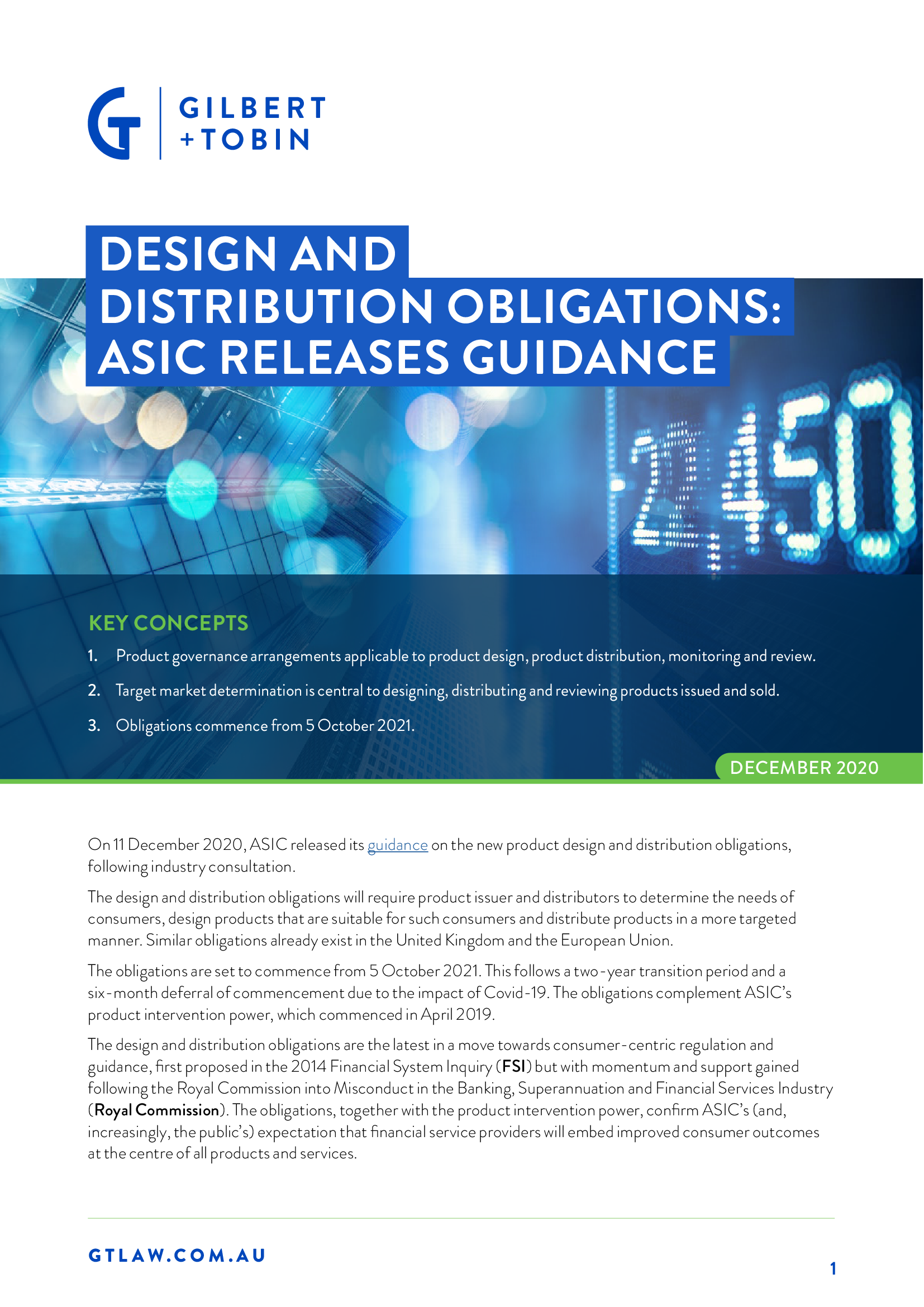On 11 December 2020, ASIC released its guidance (Regulatory Guide 274 - Product design and distribution obligations) on the new product design and distribution obligations, following industry consultation.
The design and distribution obligations will require product issuer and distributors to determine the needs of consumers, design products that are suitable for such consumers and distribute products in a more targeted manner. Similar obligations already exist in the United Kingdom and the European Union.
The obligations are set to commence from 5 October 2021. This follows a two-year transition period and a six-month deferral of commencement due to the impact of Covid-19. The obligations complement ASIC’s product intervention power, which commenced in April 2019.
The design and distribution obligations are the latest in a move towards consumer-centric regulation and guidance, first proposed in the 2014 Financial System Inquiry (FSI) but with momentum and support gained following the Royal Commission into Misconduct in the Banking, Superannuation and Financial Services Industry (Royal Commission). The obligations, together with the product intervention power, confirm ASIC’s (and, increasingly, the public’s) expectation that financial service providers will embed improved consumer outcomes at the centre of all products and services.
The product design and distribution obligations
Further to our 2018 Insight (Government releases draft bill for design and distribution obligations and product intervention power) on the exposure draft, reforms to create design and distribution obligations were passed in April 2019, with a two-year transition period to allow product issuers to prepare.
The obligations require issuers and distributors of financial products to consider the design of the product, including its key attributes, and to determine the appropriate target market for the product. That is, whether there is a class of consumers for whom the product would likely be consistent with their likely objectives, financial situation and needs. If an appropriate target market cannot be identified for a product, an issuer will not be able to offer the product.
The obligations are as follows, and each is clarified further in the released guidance:
|
Obligations for issuers |
Obligations for distributors |
|---|---|
|
Implement and maintain robust and effective product governance arrangements to ensure compliance with design and distribution obligations. ASIC guidance states the purpose of these arrangements is to assist in avoiding similar outcomes to those identified in the FSI and Royal Commission, and to assist in the management of non-financial risk. |
|
|
Prepare a target market determination for financial products. The determination must be documented and meet content requirements as set out in the Corporations Act 2001 (Cth) (Corporations Act). |
Must not engage in retail product distribution unless the distributor knows or reasonably believes that a target market determination has been made by the issuer. |
|
Make the target market determination publicly available. |
Take reasonable steps that will ,or are reasonably likely to, result in a distribution being consistent with the most recent target market determination. |
|
Take reasonable steps that will ,or are reasonably likely to, result in a distribution being consistent with the product’s target market determination. |
Notify the product issuer of any significant dealing in a product that is not consistent with the target market determination. |
|
Review the target market determination within 10 business days if the issuer knows or ought reasonably to know that the determination is no longer appropriate. |
Keep records of the number of complaints received about a product and information specified by the issuer in the target market determination. |
|
Notify ASIC of any significant dealing in a product that is not consistent with the target market determination. |
|
|
Keep records of all decisions made in relation to its target market determinations and reviews, and any distribution activities engaged in by the issuer. |
|
Coverage of the product design and distribution obligations
The coverage of the obligations is broad.
The obligations generally apply to all products available for acquisition by issue or regulated sale in Australia however only in relation to retail clients.
The obligations apply to most financial products regulated under the Corporations Act, including securities and interests requiring disclosure (eg, prospectus or product disclosure statement). Most ordinary shares, MySuper products and securities issues under employee incentive arrangements are excluded.
The obligations also apply to products that are not regulated under the Corporations Act but are within the scope of the Australian Securities and Investments Commission Act 2001 (Cth). This brings consumer credit and lease products regulated under the National Consumer Credit Protection Act 2009 (Cth) within the scope of the obligations, and also short-term credit products not currently regulated. Importantly, this may bring “Buy Now, Pay Later” products within the reach of the new obligations (see our update on this topic - ASIC releases industry update: Buy now, pay later, regulate soon).
ASIC’s role in administering the product design and distribution obligations
As part of the reform package, ASIC will be granted new powers to make a stop order to protect consumers from breaches of the design and distribution obligations. A stop order can be made where a product issuer fails to make, review or make public a target market determination or where a distributor has failed to take reasonable steps to distribute a product in a way that is consistent with a target market determination.
ASIC has stated that it may also take enforcement action, and will use its product intervention power where satisfied that the product has resulted, will result or is likely to result in significant consumer detriment.

Visit Smart Counsel

